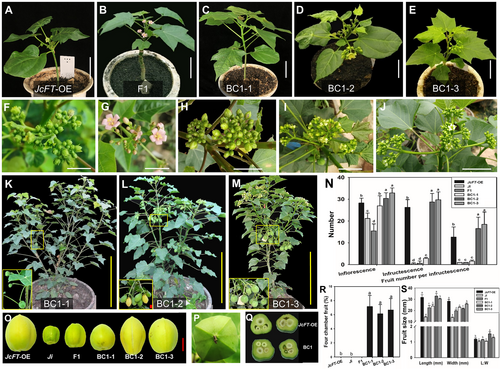Perennial woody plants like Jatropha curcas are integral to sustainable agriculture because of their potential as biofuel and ecological advantages. While transgenesis and hybridization have been extensively utilized in woody plants, a comprehensive strategy for tree breeding has not been distinctly proposed in recent years.
In a study published in Physiologia Plantarum, researchers from Xishuangbanna Tropical Botanical Garden (XTBG) of the Chinese Academy of Sciences introduced a breeding approach to address the pathogens associated with planting. Their approach combing transgenic technology and interspecific hybridization has unlocked new potential for sustainable improvement of woody crops.
Overexpression of the flowering-promoting gene JcFT (JcFT-OE) in J. curcas led to early flowering, and the resulting transgenic plants were crossbred with J. integerrima, a species known for its strong stems and bright flowers. Subsequent backcrossing (BC) of these hybrids with JcFT-OE plants further refined the desired characteristics.
This hybridization strategy yielded multiple favorable traits: JcFT overexpression significantly reduced the juvenile phase, thus speeding up breeding cycles. The F1 hybrids displayed early flowering, robust stems, enhanced xylem development, and a higher fatty acid content in seed oil compared to wildtype plants.
Nevertheless, fruit drop resulted in suboptimal seed yields. BC1 hybrids addressed the limitations of the F1, demonstrating improved seed production. The introduction of root rot tolerance and structural robustness from J. integerrima bolstered crop resilience. Additionally, new flower colorations, an increased female-to-male flower ratio, and improvements in oil quality were achieved.
"Blending transgenic tools with hybridization allows us to stack beneficial traits. This breeding approach is conducive to the development of superior varieties and has a positive impact on biodiesel production and environmental sustainability," said TANG Mingyong of XTBG.
The marked effect of JcFT overexpression in hastening flowering highlighted its significant potential to transform breeding strategies for perennial crops, including poplar, eucalyptus, and fruit trees.
According to TANG, the new breeding approach not only strengthened Jatropha's viability as a sustainable bioenergy source but also provided a scalable model for improving woody plants critical to agroforestry, carbon sequestration, and climate-resilient agriculture.

Early flowering BC1 generation by crossing between JcFT-OE and F1. (Image by BAI Xue)
Contact
TANG Mingyong Ph.D Principal Investigator
Xishuangbanna Tropical Botanical Garden, Chinese Academy of Sciences
E-mail: tangmingyong@xtbg.ac.cn
First published: 26 March 2025

